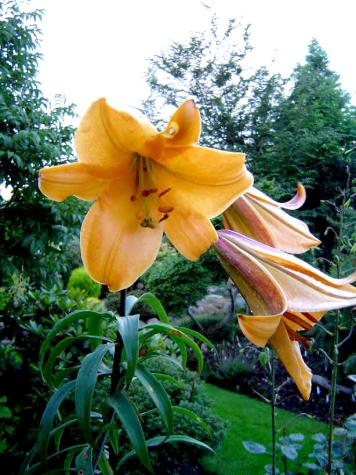Many lily hybrids grow well in Missouri.
COLUMBIA, Mo. – If you mention the word “lily” to most people, they’ll think of the Easter lily. Although an attractive potted plant, that pure white beauty struggles somewhat in Missouri’s climate if planted outdoors, said David Trinklein, state horticulture specialist for University of Missouri Extension.
But don’t lament. There are many gorgeous lily hybrids that do very well in the Show-Me State, Trinklein said. To promote this garden beauty, the National Garden Bureau has selected lily as its bulb plant of the year for 2024.
Lilies are generally categorized into nine different divisions.
“The first to bloom are the Asiatic hybrids, which flower around mid-to-late June into early July,” Trinklein said. “These lilies usually are only about 24 inches tall and have upward-facing flowers.”
The Asiatics acclimatize or naturalize themselves well in our climate and are fairly self-sufficient, he said.
In order of bloom date, the next major division includes the trumpet lilies, sometimes referred to as Aurelian hybrids. They bloom mid-to-late July or early August.
“These are the giants of the lily world and can exceed 40 inches in height. They have huge, ofttimes pendulous flowers, hanging down like a bell,” Trinklein said. “The flowers themselves might be 6 or even 8 inches in diameter.”
Because of their size, they sometimes need additional support, he said. Also, the trumpets can be more fragrant than the Asiatics.
As fragrant as the trumpet lilies are, they’re nothing when compared to the Oriental hybrids. The latter is the third major division of lily frequently planted in Missouri. Trinklein suggests this would be the lily to grow if you’re into fragrance gardening, keeping in mind that pleasant fragrance is in the nose of the beholder.
“Unfortunately, the Oriental hybrids are probably not the best choice for Missouri, although they can be grown. They're a little bit tender during the winter,” Trinklein said.
Therefore, you might want to consider planting them in a protected location near the house where the soil doesn’t get super cold, Trinklein said. If you live in a northern part of Missouri, you should probably give the Oriental hybrids a pass.
Starting with either dormant bulbs or started plants, you’ll be rewarded with beauty throughout the growing season if you plant the three groups in proper progression, he said.
“You can have lilies in bloom all the way from about the middle of June until the last part of August if you choose between the different types wisely,” Trinklein said.
Since lily bulbs can be bit more pricey than other flower bulbs, gardeners will want to plant them with care.
It’s best to amend the soil with organic matter before planting, Trinklein said. Lilies need well-drained soil, just like most flowering bulbs. If they sit in soggy soil, the bulb will rot. Using raised beds or berms can help improve drainage.
Incorporating bone meal into the soil before planting will also help the lilies thrive.
“Bone meal is really a very good bulb food. It breaks down rather slowly so that initially we would have it there and then we would top dress with bone meal on a yearly basis,” Trinklein said.
When a lily emerges from the bulb, a portion of the stem underground will sprout roots.
“Those are called stem roots,” he said. “They're very important for water and nutrient absorption and well-being of the plant. Therefore, lily bulbs are planted relatively deeply. For example, about 8 inches deep for a trumpet lily bulb.”
Lilies put on a lot more growth per season than, say, daffodils or narcissus, so they might need a bit more fertilizer, Trinklein said. It is usually added during or shortly after flowering.
Relatively pest-free, lilies make excellent cut flowers. Harvest them when the lower buds are showing color but not yet open. The vase life of lilies can be increased by removing the pollen-bearing anthers.
Photos
Tango lily
"Cappuccino" Tango lily (Asiatic hybrid). Photo by Bill Murray.
Trumpet lily
"African Queen" trumpet lily (Aurelian hybrid). Photo by Thorkild Poulsen.
Dizzy lily
"Dizzy" (Oriental hybrid). Photo by Bill Murray.
